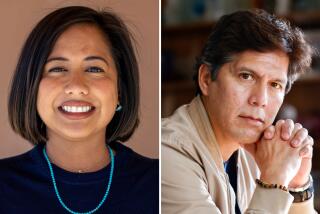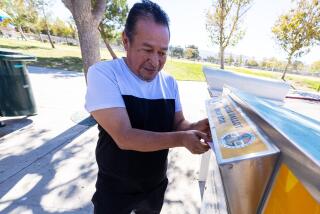Coalition to Propose Two Latino Council Seats in Valley : Politics: The redistricting plan adds a ‘growth’ district based on projected population growth. The city charter requires adoption of a plan by July.
- Share via
A coalition of civil rights groups is proposing to reapportion the Los Angeles City Council to create two heavily Latino districts in the San Fernando Valley, with the second seat probably going initially to a refugee lawmaker displaced from the Westside.
Broad outlines of the plan by the Latino Redistricting Coalition of Los Angeles have been worked out, but a detailed map won’t be ready until next week, leaders of the group say.
It calls for not just one Latino-dominated district in the Valley--as was expected--but two.
The coalition also recently unveiled its plan for redrawing boundaries of the Los Angeles school board to create a new Latino-influenced district in the Valley. As a side effect, this plan would extend Valley board member Julie Korenstein’s 4th District over the Santa Monica Mountains and into the Westside for the first time.
The politically riskiest element in the coalition’s City Council plan calls for a second, “growth” Latino district running from Sylmar, through Mission Hills, Panorama City and Van Nuys and southward into North Hollywood, say those familiar with it.
This district would be 40% Latino but only about 15% of its registered voters would be Latino, said Edward Guzman, a coalition member and president of the Valley chapter of the Mexican-American Political Assn.
It would be a growth district, because if existing population trends in the East Valley continue, Latinos will constitute a majority there in less than a decade.
Coalition Chairman Marshall Diaz outlined the plan in broad terms at a hearing Tuesday before the City Council’s Ad Hoc Redistricting Committee.
Under the city charter, the council must adopt a new remap plan by July. But the political problems that incumbents would suffer from creation of a second Latino district in the Valley may make it very difficult to get the proposal through the council, City Hall sources say.
“No one’s ever talked to me about it, and I’m chairman of the committee,” Council President John Ferraro said Wednesday.
“I don’t see any support for it,” said Greig Smith, chief deputy to Councilman Hal Bernson, the only Valley lawmaker on the committee to which the plan was presented.
The most commonly discussed scenario for creating the second seat involves collapsing one of three Westside districts--all of which are growing more slowly than other parts of the city--and dropping it into the East Valley, where Latino migration and birth rates are causing explosive growth.
The best bet, according to City Hall and Latino observers, is that the coalition will suggest abolishing Councilwoman Ruth Galanter’s present 6th District and transplanting it to the East Valley to create the new district.
Galanter, who lives in Venice, could represent the transplanted seat until 1995, when her current term expires. Then, if she wanted to run for reelection from that district, she would have to move into it.
Galanter recently told The Times she would fight any attempt to break up her current district, which includes the Crenshaw area, Westchester, Venice and Mar Vista.
Meanwhile, the coalition’s plan for the first Latino-dominated district in the Valley is decidedly less controversial.
Councilman Ernani Bernardi’s existing 7th District in the East Valley already has a Latino majority.
But the coalition plan would boost the number of Latino registered voters in the 7th District by reshaping its boundaries to include more voter-rich neighborhoods, strengthening the chances for election of the first Latino council member from the Valley, said Alan Clayton, a reapportionment specialist with the coalition and top aide to state Sen. Art Torres (D-Los Angeles). The council currently has two Latino members.
Latinos make up 62.3% of the existing 7th District’s population but only 26.2% of its registered voters. The reconfigured district envisioned by the coalition would be 68% Latino, and the proportion of Latino registered voters would rise to 30%.
The core of the proposed district would be in Pacoima and include Arleta, Lake View Terrace, Sun Valley and parts of North Hollywood.
If the council tried to fragment the 7th District to dilute its Latino population, the coalition would ask the U.S. Department of Justice to sue the city under the federal Voting Rights Act, charging racial discrimination, Clayton said.
On the other hand, if the council created a strongly Latino 7th District seat but not the second Latino growth seat, “we would probably ask Justice to take a look at it, although it would be a tougher call” to sue, Clayton said.
Creation of a predominantly Latino 7th District also is quietly applauded by a host of ambitious young Latinos who plan to seek election to that seat in 1993 when Bernardi’s current term expires. The 80-year-old Bernardi, who has served on the council since 1961, has said he will not seek reelection.
More to Read
Sign up for Essential California
The most important California stories and recommendations in your inbox every morning.
You may occasionally receive promotional content from the Los Angeles Times.










